Watched November 26 -- December 2, 2007: Barnet, Somai, Jeong, Bong
U samogo sinyego morya / By the Bluest of Seas (Boris Barnet, 1936)
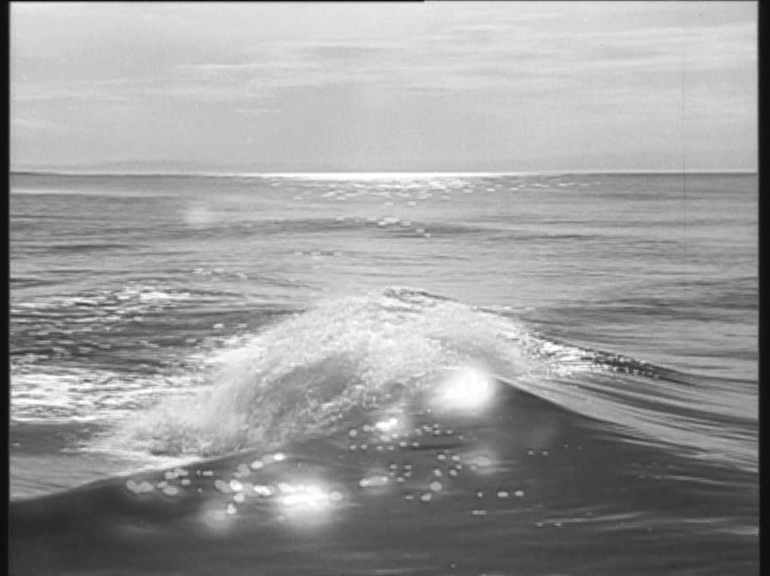 Barnet's film takes place in the Caspian Sea -- and an on an island in that sea. But he starts the film with water and waves and two shipwrecked sailors -- and the marine cinematography by Mikhail Kirillov is absolutely stunning.
Barnet's film takes place in the Caspian Sea -- and an on an island in that sea. But he starts the film with water and waves and two shipwrecked sailors -- and the marine cinematography by Mikhail Kirillov is absolutely stunning.  The sailors Alyosha (Nikolai Kryuchkov) and Yussuf (Lev Sverdlin) are rescued by members of a fishing commune on an island in the Southern Caspian. Soon after their arrival, both are smitten by Misha, a pretty commune supervisor
The sailors Alyosha (Nikolai Kryuchkov) and Yussuf (Lev Sverdlin) are rescued by members of a fishing commune on an island in the Southern Caspian. Soon after their arrival, both are smitten by Misha, a pretty commune supervisor  (Yelena Kuzmina, star of Kozintsev and Trauberg's New Babylon and Alone). They both go to work for the commune, and compete for the attention of Misha, using means both fair and foul, which puts a considerable strain on their comradeship. As it turns out, she is already engaged to a sailor serving in the Soviet Union's Pacific fleet, so the two set off together (friends again), back across the Caspian to their own hometown.
(Yelena Kuzmina, star of Kozintsev and Trauberg's New Babylon and Alone). They both go to work for the commune, and compete for the attention of Misha, using means both fair and foul, which puts a considerable strain on their comradeship. As it turns out, she is already engaged to a sailor serving in the Soviet Union's Pacific fleet, so the two set off together (friends again), back across the Caspian to their own hometown.
 An utterly delightful (and beautiful) film -- it has helped solidify Barnet's spot as one of my favorite Soviet directors. One can't help wondering why Barnet's lovely film is so comparatively ignored today. Perhaps the fact that it is totally uncategorizable hurts it -- part low comedy, past romance, part socialist propaganda, part musical.
An utterly delightful (and beautiful) film -- it has helped solidify Barnet's spot as one of my favorite Soviet directors. One can't help wondering why Barnet's lovely film is so comparatively ignored today. Perhaps the fact that it is totally uncategorizable hurts it -- part low comedy, past romance, part socialist propaganda, part musical.  Moreover, this is part silent (with intertitles and a synchronized musical score) and part talkie. As beautifully crafted as the film is, it feels unsophisticated, too much aimed at common audiences. At the moment, the only subbed DVD release (from Bach Films), is subbed only in French. It does not appear that much restoration was done for this release, but for the most part this looks lovely, despite the damaged condition of the underlying source print.
Moreover, this is part silent (with intertitles and a synchronized musical score) and part talkie. As beautifully crafted as the film is, it feels unsophisticated, too much aimed at common audiences. At the moment, the only subbed DVD release (from Bach Films), is subbed only in French. It does not appear that much restoration was done for this release, but for the most part this looks lovely, despite the damaged condition of the underlying source print.
Lots more pictures:
http://i9.photobucket.com/albums/a59/mkerpan/barnet/blue01.png
http://i9.photobucket.com/albums/a59/mkerpan/barnet/blue01.png
http://i9.photobucket.com/albums/a59/mkerpan/barnet/blue04.png
http://i9.photobucket.com/albums/a59/mkerpan/barnet/blue05.png
http://i9.photobucket.com/albums/a59/mkerpan/barnet/blue07.png
http://i9.photobucket.com/albums/a59/mkerpan/barnet/blue09.png
http://i9.photobucket.com/albums/a59/mkerpan/barnet/blue11.png
http://i9.photobucket.com/albums/a59/mkerpan/barnet/blue12.png
http://i9.photobucket.com/albums/a59/mkerpan/barnet/blue13.png
http://i9.photobucket.com/albums/a59/mkerpan/barnet/blue14.png
http://i9.photobucket.com/albums/a59/mkerpan/barnet/blue15.png
http://i9.photobucket.com/albums/a59/mkerpan/barnet/blue16.png
Novgorodtsy / Men of Novgord / A Good Lad (Boris Barnet, 1943)
 This war film by Boris Barnet is almost as heterogeneous as By the Bluest of Seas. This film involves a group of partisans who rescue a downed French airman (Viktor Dobrovolsky) in Nazi-occupied Western Russia.
This war film by Boris Barnet is almost as heterogeneous as By the Bluest of Seas. This film involves a group of partisans who rescue a downed French airman (Viktor Dobrovolsky) in Nazi-occupied Western Russia.  Despite the lack of any mutually intelligible language at first, our hero finds romance and aid in trying to restore a downed German airplane to working order. As it turns out,
Despite the lack of any mutually intelligible language at first, our hero finds romance and aid in trying to restore a downed German airplane to working order. As it turns out, 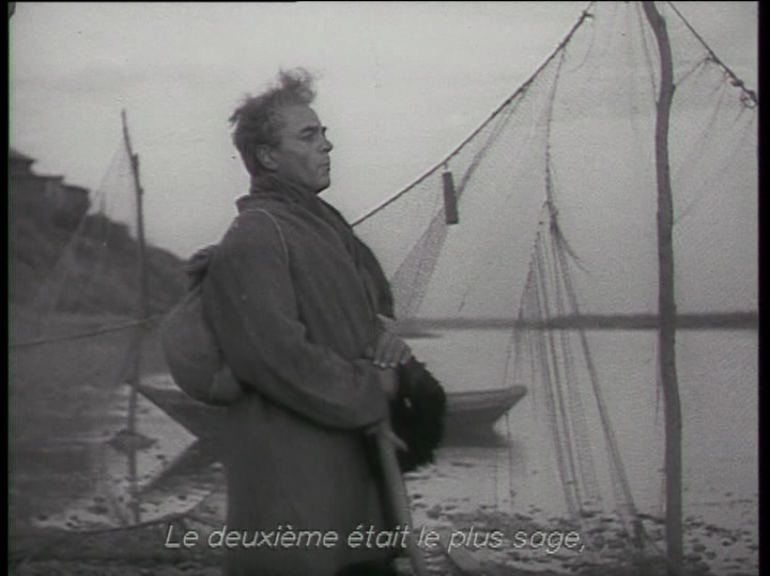 the partisans have found the location of a secret enemy airbase (with the aid of a heroic refugee opera singer), and our pilot needs to get back to his base to lead an air raid to destroy it. Despite its length (just over an hour), the film involves plenty of comedy and music (both folk style and classical) in addition to drama, suspense and romance.
the partisans have found the location of a secret enemy airbase (with the aid of a heroic refugee opera singer), and our pilot needs to get back to his base to lead an air raid to destroy it. Despite its length (just over an hour), the film involves plenty of comedy and music (both folk style and classical) in addition to drama, suspense and romance.
Visually, this isn't quite as splendid as By the Bluest of Seas. And the cast isn't quite as skilled. But the film is still worth seeing (if one gets a chance). Curiously, while this film was shown extensively to Soviet troops in the field (and was quite popular with them), it was banned from exhibition in Russia's towns and cities. One wonders what led to the simultaneous promotion and suppression of a film that certainly seemed patriotic enough for domestic consumption.
And the cast isn't quite as skilled. But the film is still worth seeing (if one gets a chance). Curiously, while this film was shown extensively to Soviet troops in the field (and was quite popular with them), it was banned from exhibition in Russia's towns and cities. One wonders what led to the simultaneous promotion and suppression of a film that certainly seemed patriotic enough for domestic consumption.
More screen shots:
http://i9.photobucket.com/albums/a59/mkerpan/barnet/lad02.png
http://i9.photobucket.com/albums/a59/mkerpan/barnet/lad03.png
http://i9.photobucket.com/albums/a59/mkerpan/barnet/lad04.png
http://i9.photobucket.com/albums/a59/mkerpan/barnet/lad05.png
http://i9.photobucket.com/albums/a59/mkerpan/barnet/lad06.png
http://i9.photobucket.com/albums/a59/mkerpan/barnet/lad09.png
http://i9.photobucket.com/albums/a59/mkerpan/barnet/lad10.png
http://i9.photobucket.com/albums/a59/mkerpan/barnet/lad12.png
Ohikkoshi /Moving (Shinji Sômai, 1993)
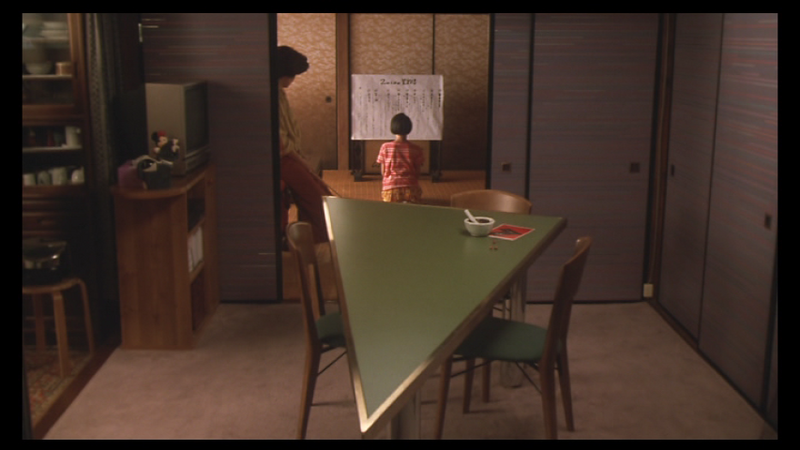 Of all the wonderful foreign "family films" that have never been distributed in the West, Ohikkoshi is the film whose neglect is most mystifying to me. It is almost certainly the best film ever made (to date) on the impact of divorce on a child.
Of all the wonderful foreign "family films" that have never been distributed in the West, Ohikkoshi is the film whose neglect is most mystifying to me. It is almost certainly the best film ever made (to date) on the impact of divorce on a child. 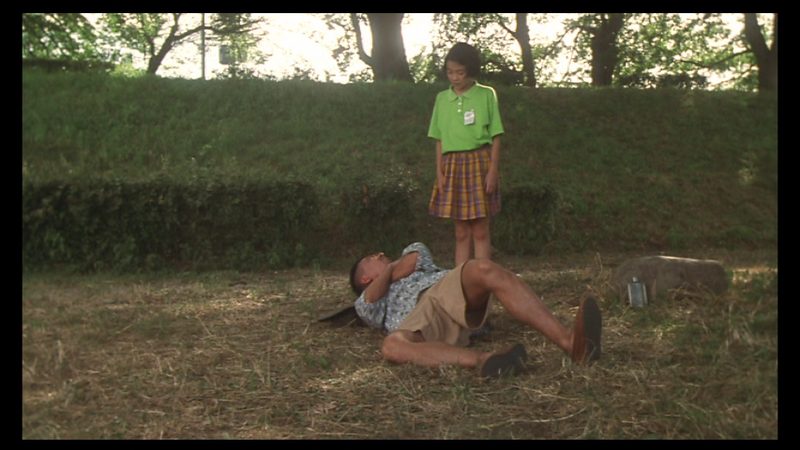 It manages to be both honest and yet still (ultimately) hopeful It is beautifully filmed -- and its star, twelve year-old Tomoko Tabata, gives one of the best performances by a child ever captured on film. In addition, it may be the only live-action film that seems to have both been inspired by the work of Ghibli Studios (particularly Takahata's Grave of the Fireflies and Only Yesterday) and provided a source of inspiration in return (to Miyazaki's Spirited Away).
It manages to be both honest and yet still (ultimately) hopeful It is beautifully filmed -- and its star, twelve year-old Tomoko Tabata, gives one of the best performances by a child ever captured on film. In addition, it may be the only live-action film that seems to have both been inspired by the work of Ghibli Studios (particularly Takahata's Grave of the Fireflies and Only Yesterday) and provided a source of inspiration in return (to Miyazaki's Spirited Away).
 Renko's parents both seem to be decent enough people and both love her well enough -- but they just can't stand living together any longer. At first, Renko seems (relatively) unflustered by her father's move to an apartment in another part of town.
Renko's parents both seem to be decent enough people and both love her well enough -- but they just can't stand living together any longer. At first, Renko seems (relatively) unflustered by her father's move to an apartment in another part of town.  But she begins getting into trouble at school, and also starts dreaming up schemes to reunite her parents. The culmination of her efforts is a visit to Lake Biwa for a fire festival, an event she attended when she was younger (before her family life became troubled by parental discord).
But she begins getting into trouble at school, and also starts dreaming up schemes to reunite her parents. The culmination of her efforts is a visit to Lake Biwa for a fire festival, an event she attended when she was younger (before her family life became troubled by parental discord).  Initially a bit amused by her daughter's somewhat underhanded shenanigans, Renko's mother (former pop music star Junko Sakurada) gets extremely upset when she discovers her daughter has invited her father (Kiichi Nakai) as well.
Initially a bit amused by her daughter's somewhat underhanded shenanigans, Renko's mother (former pop music star Junko Sakurada) gets extremely upset when she discovers her daughter has invited her father (Kiichi Nakai) as well. 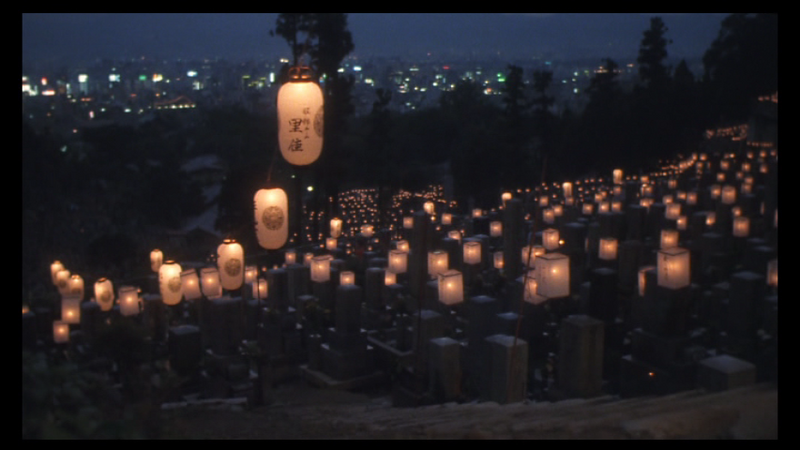 After being reassured by her father that he still loves her, she sets off for a solo odyssey. Along the way, she is temporarily "adopted" by an elderly couple she meets by chance. After a frantic search, her mother catches sight of her at nightfall --
After being reassured by her father that he still loves her, she sets off for a solo odyssey. Along the way, she is temporarily "adopted" by an elderly couple she meets by chance. After a frantic search, her mother catches sight of her at nightfall -- 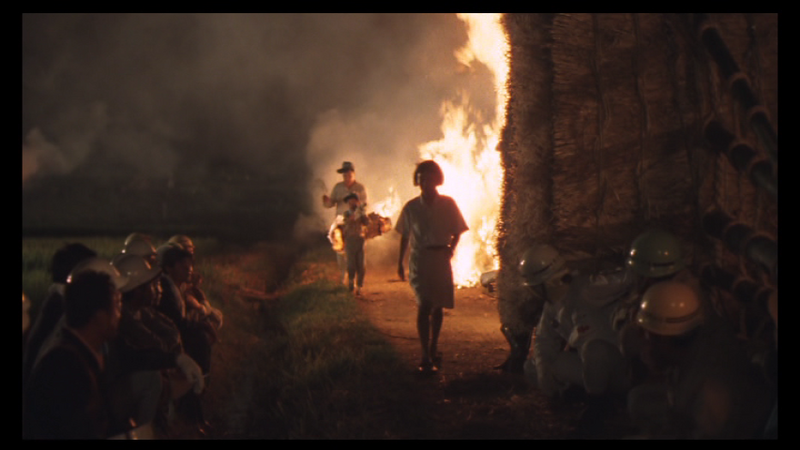 only to be told "I'll see you tomorow morning" as Renko slips away again (after promising her protectors that she'd see them again next year). She spends the night at the fire festival, in a bamboo forest on a hill overlooking the festival site (where she prays to the moon), and then on the shore of Lake Biwa -- where she falls asleep and dreams.
only to be told "I'll see you tomorow morning" as Renko slips away again (after promising her protectors that she'd see them again next year). She spends the night at the fire festival, in a bamboo forest on a hill overlooking the festival site (where she prays to the moon), and then on the shore of Lake Biwa -- where she falls asleep and dreams.  In the morning, as Renko warms herself over a little fire she made, she is greeted by her mother. Having finally confronted the reality of her situation, Renko is ready to return to school -- where she must make a speech about her family (which she had previously dreaded) and get ready for the passing from elementary school to middle school.
In the morning, as Renko warms herself over a little fire she made, she is greeted by her mother. Having finally confronted the reality of her situation, Renko is ready to return to school -- where she must make a speech about her family (which she had previously dreaded) and get ready for the passing from elementary school to middle school.
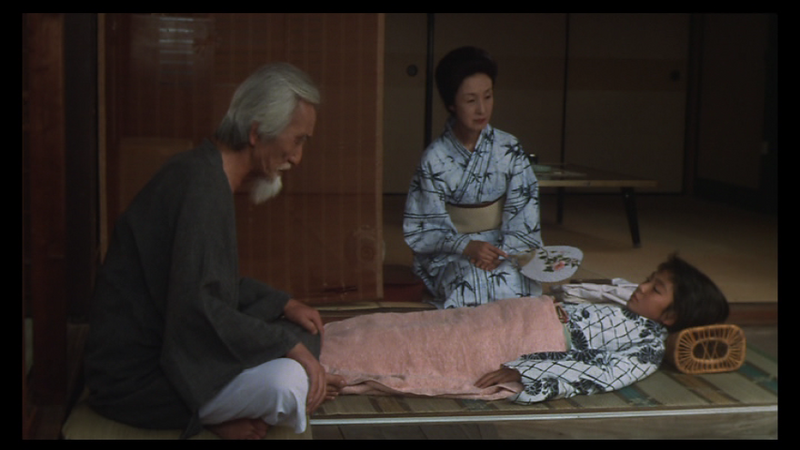 "Ohikkoshi" as used in the film's title literally means "moving" as in "moving from one place to another". Metaphorically, it stands for the heroine's from one situation (and state of mind) to another.
"Ohikkoshi" as used in the film's title literally means "moving" as in "moving from one place to another". Metaphorically, it stands for the heroine's from one situation (and state of mind) to another.  As noted above. As with Miyazaki in Spirited Away (another film that centers around "moving"), the young heroine's process of growth and transformation is totally entwined with Shinto motifs and concepts. If this film were ever to appear on DVD in the West, a comprehensive primer on Shintoism and Shinto rites would probably enrich viewers' experience considerably.
As noted above. As with Miyazaki in Spirited Away (another film that centers around "moving"), the young heroine's process of growth and transformation is totally entwined with Shinto motifs and concepts. If this film were ever to appear on DVD in the West, a comprehensive primer on Shintoism and Shinto rites would probably enrich viewers' experience considerably.
 Alas, at present, the film is only available as a barebones, unsubbed Japanese DVD of decent (but not superlative) quality. To complicate matters more, the film makes considerable use of Kansai dialects, so even students of Japanese might find some of the dialog rough going.
Alas, at present, the film is only available as a barebones, unsubbed Japanese DVD of decent (but not superlative) quality. To complicate matters more, the film makes considerable use of Kansai dialects, so even students of Japanese might find some of the dialog rough going. 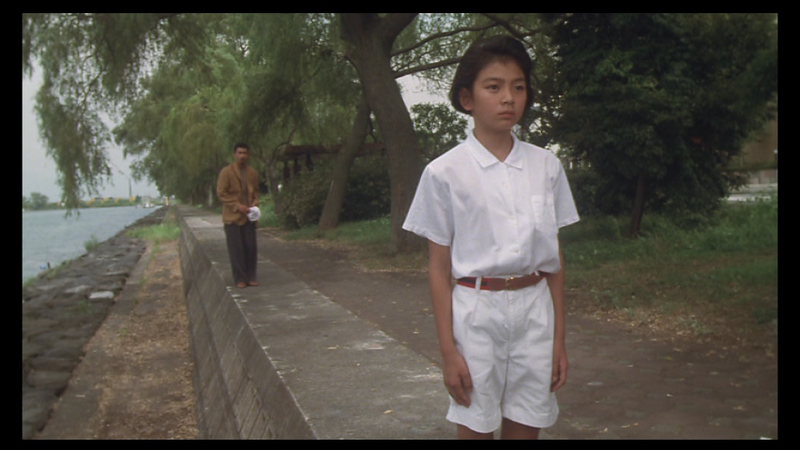 On the other hand, most of the last 45 minutes of the film (which covers Renko's solo quest) are virtually wordless. I recently showed the film to a friend who doesn't understand Japanese, and he was nonetheless left in awe by it. Unfortunately, its creator Shinji Sômai died in 2001 at much too young an age (early 50s),
On the other hand, most of the last 45 minutes of the film (which covers Renko's solo quest) are virtually wordless. I recently showed the film to a friend who doesn't understand Japanese, and he was nonetheless left in awe by it. Unfortunately, its creator Shinji Sômai died in 2001 at much too young an age (early 50s), 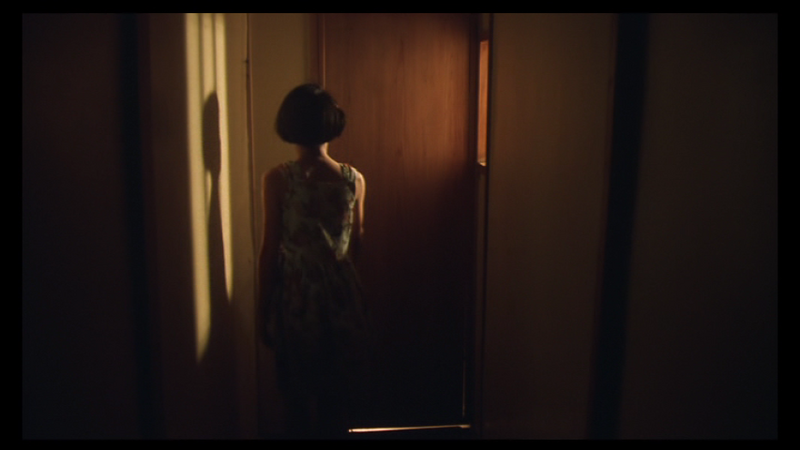 so the film must depend on well-wishers to promote it (and Sômai's other important, but now-neglected films -- such as Typhoon Club). Surely, someday, some enterprising Western DVD company will belatedly discover this remarkable (and indispensable) film and make it available.
so the film must depend on well-wishers to promote it (and Sômai's other important, but now-neglected films -- such as Typhoon Club). Surely, someday, some enterprising Western DVD company will belatedly discover this remarkable (and indispensable) film and make it available.
Girl's Night Out (JEONG Jae-eun, 1999)
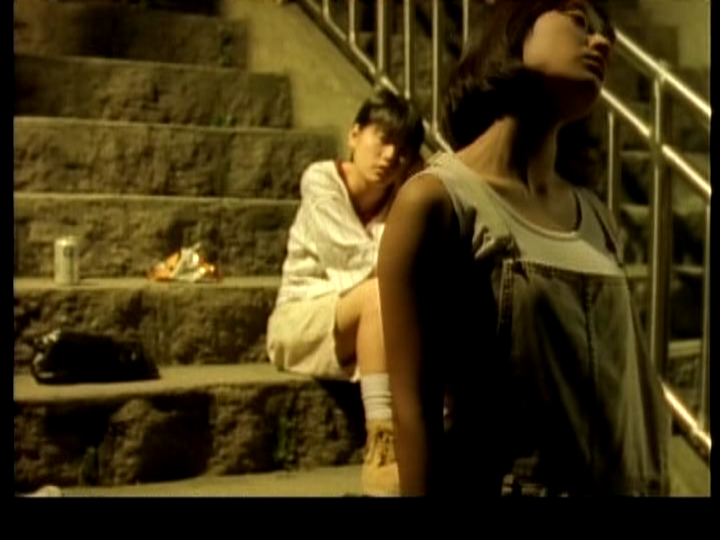 Prior to making her first full length film, Take Care of My Cat, Jeong made three short films. Two of these are available as supplements to the Korean DVD release of TCoMC. This little film about two high school girls who are friends is, in some ways, like a preliminary sketch for TCoMC.
Prior to making her first full length film, Take Care of My Cat, Jeong made three short films. Two of these are available as supplements to the Korean DVD release of TCoMC. This little film about two high school girls who are friends is, in some ways, like a preliminary sketch for TCoMC. 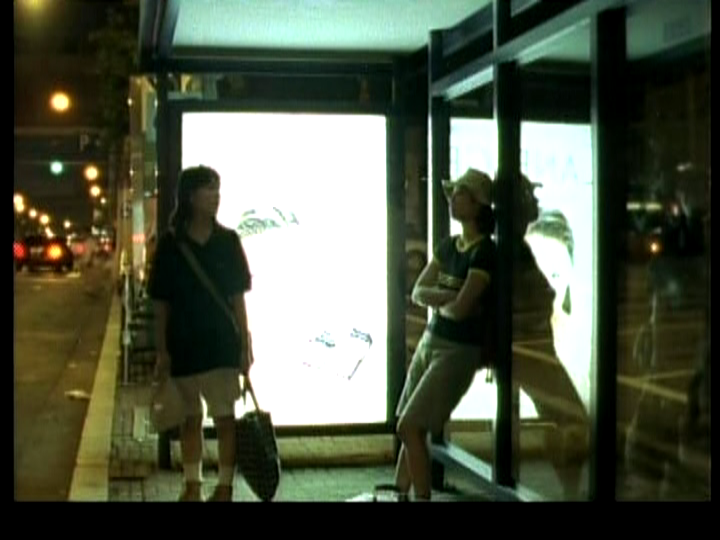 One girl is obsessed with photography, but can't afford a real camera. The other girl is obsessed by a hunky older cousin (who takes advantage of her). Both have family problems that complicate their lives. The girls for a day trip to a cheesy coastal resort -- and then come back late in the evening, but still in time to watch an important soccer match on television
One girl is obsessed with photography, but can't afford a real camera. The other girl is obsessed by a hunky older cousin (who takes advantage of her). Both have family problems that complicate their lives. The girls for a day trip to a cheesy coastal resort -- and then come back late in the evening, but still in time to watch an important soccer match on television
This naturalistic little film moves at a seemingly slow pace -- but covers a surprisingly large slice of the girls' lives. It anticipates the patient and attentive gaze on young subjects Jeong she would exhibit in TCoMC and The Aggressives. Unfortunately, the (in my opinion, quite nice) latter film garnered little in the way of critical or audience support, so Jeong's career appears (at least for now) to have shifted into slow gear.
but covers a surprisingly large slice of the girls' lives. It anticipates the patient and attentive gaze on young subjects Jeong she would exhibit in TCoMC and The Aggressives. Unfortunately, the (in my opinion, quite nice) latter film garnered little in the way of critical or audience support, so Jeong's career appears (at least for now) to have shifted into slow gear.
Some more screen shots:
http://i9.photobucket.com/albums/a59/mkerpan/jeong/girls01.png
http://i9.photobucket.com/albums/a59/mkerpan/jeong/girls02.png
http://i9.photobucket.com/albums/a59/mkerpan/jeong/girls03.png
http://i9.photobucket.com/albums/a59/mkerpan/jeong/girls04.png
http://i9.photobucket.com/albums/a59/mkerpan/jeong/girls06.png
Flandersui gae / Barking Dogs Neve Bite (BONG Joon-ho, 2000)
 Although Bong's subsequent films, Memories of Murder and The Host, were both excellent, I still like his first feature film best of all. It has an audacity and imaginativeness that is quite winning -- unless one is put off by (fictional) abuse of small dogs.
Although Bong's subsequent films, Memories of Murder and The Host, were both excellent, I still like his first feature film best of all. It has an audacity and imaginativeness that is quite winning -- unless one is put off by (fictional) abuse of small dogs.  The films (at least on DVD) starts off with the assurance that no dogs were harmed in the making of the film -- which is nice to know in advance. As a life-long dog lover, I found the film's robust dog humor hilarious (on the other hand, all MY dogs have been large ones).
The films (at least on DVD) starts off with the assurance that no dogs were harmed in the making of the film -- which is nice to know in advance. As a life-long dog lover, I found the film's robust dog humor hilarious (on the other hand, all MY dogs have been large ones).
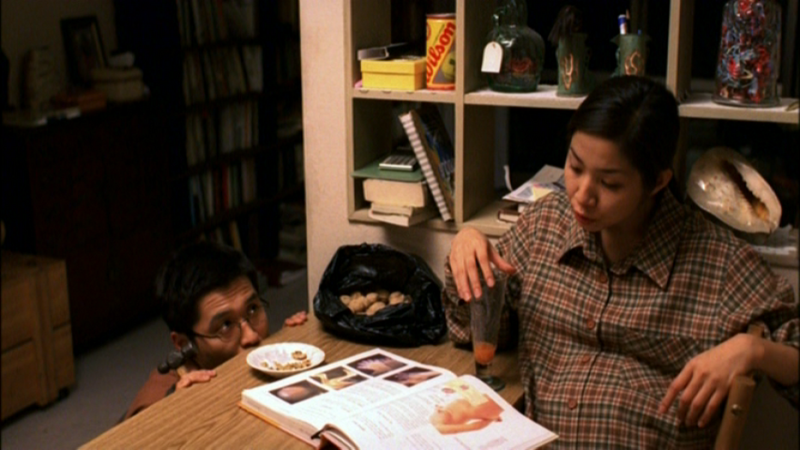 The protagonist (LEE Sung-jae) is a would-be academic, currently unemployed for lack of a timely, well-placed bribe. Currently unemployed, and relying on the earnings of his very pregnant wife (KIM Ho-jung), he has gotten increasingly irritable. And nothing irritates him more than the yapping of small dogs in and around his apartment building
The protagonist (LEE Sung-jae) is a would-be academic, currently unemployed for lack of a timely, well-placed bribe. Currently unemployed, and relying on the earnings of his very pregnant wife (KIM Ho-jung), he has gotten increasingly irritable. And nothing irritates him more than the yapping of small dogs in and around his apartment building  (where dogs are technically forbidden). When he has a chance to grab what he thinks is the offending dog, he seizes it. Unable to throw it off the roof (as he planned), he hides it in the basement. When he discovers that he got the wrong dog, he goes to let it out -- but discovers that he building's janitor (played by the marvelous Byeon Hee-bong) has turned the poor little pooch into that night's dinner.
(where dogs are technically forbidden). When he has a chance to grab what he thinks is the offending dog, he seizes it. Unable to throw it off the roof (as he planned), he hides it in the basement. When he discovers that he got the wrong dog, he goes to let it out -- but discovers that he building's janitor (played by the marvelous Byeon Hee-bong) has turned the poor little pooch into that night's dinner.  Unchastened (or, at least, insufficiently chastened), he nabs the dog whose yips drive him nuts -- and this time does throw it off the roof. He is observed, however, by the apartment complex's bookkeeping assistant (BAE Doo-na) and her pudgy friend (GO soo-hee), who runs a nearby convenience store.
Unchastened (or, at least, insufficiently chastened), he nabs the dog whose yips drive him nuts -- and this time does throw it off the roof. He is observed, however, by the apartment complex's bookkeeping assistant (BAE Doo-na) and her pudgy friend (GO soo-hee), who runs a nearby convenience store.
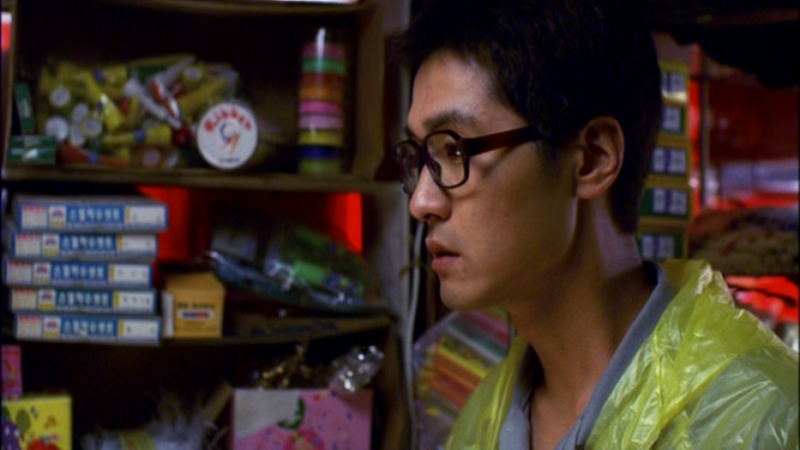 Lee's life becomes more complicated when his wife brings home a poodle -- and makes him the dog's unwilling daytime attendant. When he loses the dog through gross negligence (but not on purpose, as his wife believes), his days are devoted to dog hunting. His path crosses Bae's again when he needs to get approval for the "missing dog" posters he needs to distribute.
Lee's life becomes more complicated when his wife brings home a poodle -- and makes him the dog's unwilling daytime attendant. When he loses the dog through gross negligence (but not on purpose, as his wife believes), his days are devoted to dog hunting. His path crosses Bae's again when he needs to get approval for the "missing dog" posters he needs to distribute. 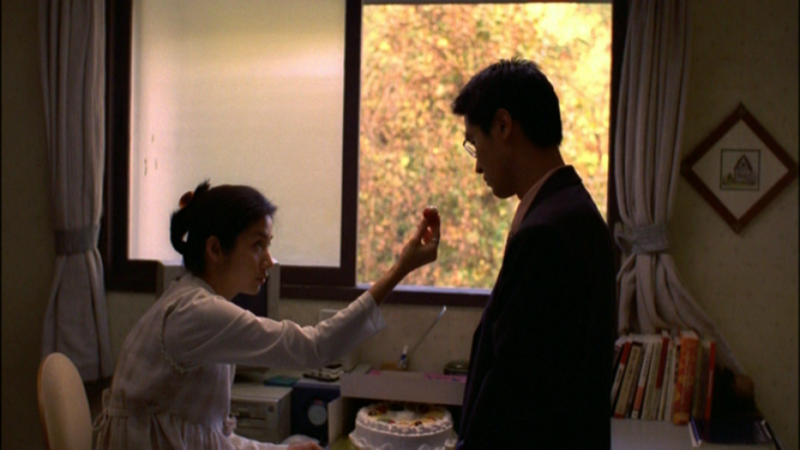 Bae is sympathetic to his plight, as the third dog-napping "victim" in recent days. Bae is so devoted to dog hunting, she loses her job. Meanwhile, Lee is able to put together a proper bribe -- as his wife has had to quit work due to her pregnancy, and her severance pay is just enough to pay off Lee's academic superior. When is all is said and done, one wonders whther Bong has presented a Buddhist parable in the guise of an unusually good-natured black comedy.
Bae is sympathetic to his plight, as the third dog-napping "victim" in recent days. Bae is so devoted to dog hunting, she loses her job. Meanwhile, Lee is able to put together a proper bribe -- as his wife has had to quit work due to her pregnancy, and her severance pay is just enough to pay off Lee's academic superior. When is all is said and done, one wonders whther Bong has presented a Buddhist parable in the guise of an unusually good-natured black comedy.
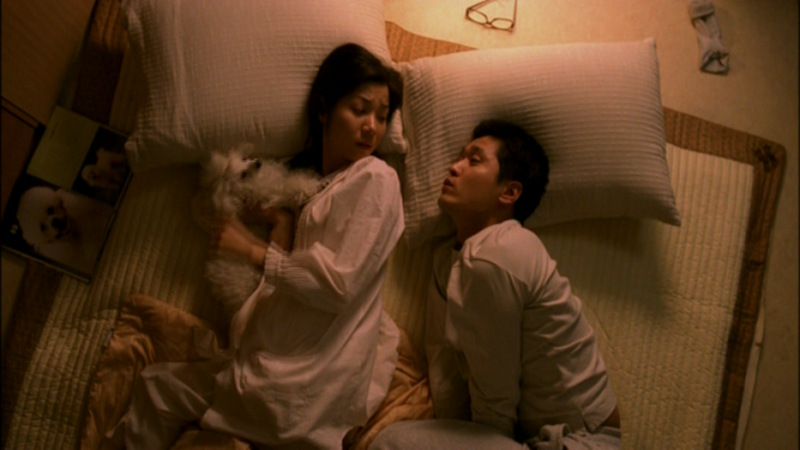 This film is structured almost precisely like a classic screwball comedy -- with one important difference; there is not even the tiniest hint of a romantic connection between Lee and Bae.
This film is structured almost precisely like a classic screwball comedy -- with one important difference; there is not even the tiniest hint of a romantic connection between Lee and Bae.  Lee is devoted, without question, to his wife (if not to her dog) and Bae's affections (non-romantic, at that) seem focused on her buddy. The couple interact together only on a common quest (and as unwitting pursuer on an unknown pursued).
Lee is devoted, without question, to his wife (if not to her dog) and Bae's affections (non-romantic, at that) seem focused on her buddy. The couple interact together only on a common quest (and as unwitting pursuer on an unknown pursued). 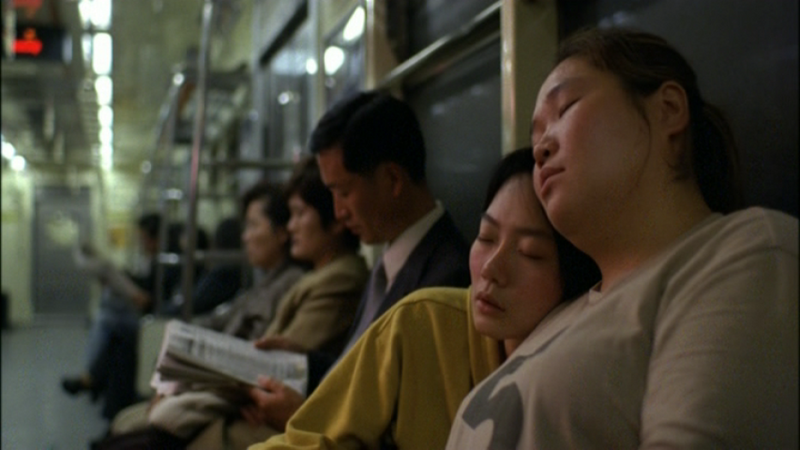 The film has innumerable wonderful moments, but perhaps none so wonderful as a lengthy story told by the janitor to the building manager (as they wait for the dog stew to finish cooking) -- about a phantom boiler repairman (Boiler Kim).
The film has innumerable wonderful moments, but perhaps none so wonderful as a lengthy story told by the janitor to the building manager (as they wait for the dog stew to finish cooking) -- about a phantom boiler repairman (Boiler Kim).
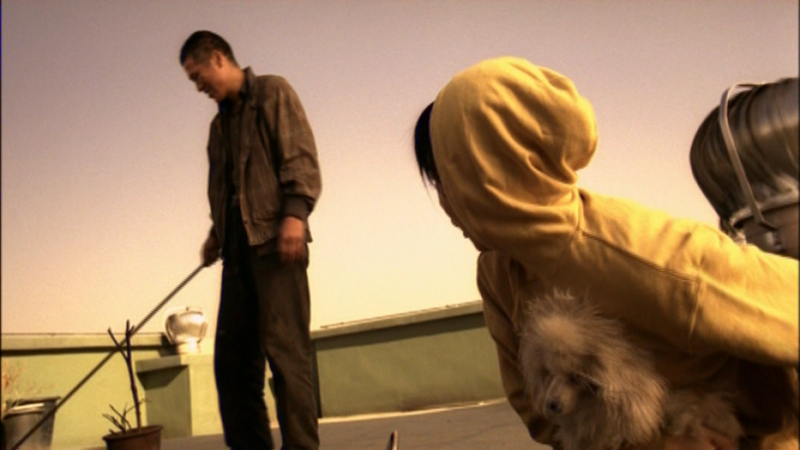 The cinematography by Choi Young-hwan is superb. And so are all the performer. And so is the jazzy underscore (and the punk rock song played during the closing credits).
The cinematography by Choi Young-hwan is superb. And so are all the performer. And so is the jazzy underscore (and the punk rock song played during the closing credits).  Although this is probably the kind of film W.C. Fields would surely have loved, the chance of this film being released in the United States today appear slim (to none). Luckily, the Korean and Hong Kong DVDs both have English subtitles. The Korean DVD looks fine (HK DVD unseen by me).
Although this is probably the kind of film W.C. Fields would surely have loved, the chance of this film being released in the United States today appear slim (to none). Luckily, the Korean and Hong Kong DVDs both have English subtitles. The Korean DVD looks fine (HK DVD unseen by me).
 Barnet's film takes place in the Caspian Sea -- and an on an island in that sea. But he starts the film with water and waves and two shipwrecked sailors -- and the marine cinematography by Mikhail Kirillov is absolutely stunning.
Barnet's film takes place in the Caspian Sea -- and an on an island in that sea. But he starts the film with water and waves and two shipwrecked sailors -- and the marine cinematography by Mikhail Kirillov is absolutely stunning.  The sailors Alyosha (Nikolai Kryuchkov) and Yussuf (Lev Sverdlin) are rescued by members of a fishing commune on an island in the Southern Caspian. Soon after their arrival, both are smitten by Misha, a pretty commune supervisor
The sailors Alyosha (Nikolai Kryuchkov) and Yussuf (Lev Sverdlin) are rescued by members of a fishing commune on an island in the Southern Caspian. Soon after their arrival, both are smitten by Misha, a pretty commune supervisor  (Yelena Kuzmina, star of Kozintsev and Trauberg's New Babylon and Alone). They both go to work for the commune, and compete for the attention of Misha, using means both fair and foul, which puts a considerable strain on their comradeship. As it turns out, she is already engaged to a sailor serving in the Soviet Union's Pacific fleet, so the two set off together (friends again), back across the Caspian to their own hometown.
(Yelena Kuzmina, star of Kozintsev and Trauberg's New Babylon and Alone). They both go to work for the commune, and compete for the attention of Misha, using means both fair and foul, which puts a considerable strain on their comradeship. As it turns out, she is already engaged to a sailor serving in the Soviet Union's Pacific fleet, so the two set off together (friends again), back across the Caspian to their own hometown. An utterly delightful (and beautiful) film -- it has helped solidify Barnet's spot as one of my favorite Soviet directors. One can't help wondering why Barnet's lovely film is so comparatively ignored today. Perhaps the fact that it is totally uncategorizable hurts it -- part low comedy, past romance, part socialist propaganda, part musical.
An utterly delightful (and beautiful) film -- it has helped solidify Barnet's spot as one of my favorite Soviet directors. One can't help wondering why Barnet's lovely film is so comparatively ignored today. Perhaps the fact that it is totally uncategorizable hurts it -- part low comedy, past romance, part socialist propaganda, part musical.  Moreover, this is part silent (with intertitles and a synchronized musical score) and part talkie. As beautifully crafted as the film is, it feels unsophisticated, too much aimed at common audiences. At the moment, the only subbed DVD release (from Bach Films), is subbed only in French. It does not appear that much restoration was done for this release, but for the most part this looks lovely, despite the damaged condition of the underlying source print.
Moreover, this is part silent (with intertitles and a synchronized musical score) and part talkie. As beautifully crafted as the film is, it feels unsophisticated, too much aimed at common audiences. At the moment, the only subbed DVD release (from Bach Films), is subbed only in French. It does not appear that much restoration was done for this release, but for the most part this looks lovely, despite the damaged condition of the underlying source print.Lots more pictures:
http://i9.photobucket.com/albums/a59/mkerpan/barnet/blue01.png
http://i9.photobucket.com/albums/a59/mkerpan/barnet/blue01.png
http://i9.photobucket.com/albums/a59/mkerpan/barnet/blue04.png
http://i9.photobucket.com/albums/a59/mkerpan/barnet/blue05.png
http://i9.photobucket.com/albums/a59/mkerpan/barnet/blue07.png
http://i9.photobucket.com/albums/a59/mkerpan/barnet/blue09.png
http://i9.photobucket.com/albums/a59/mkerpan/barnet/blue11.png
http://i9.photobucket.com/albums/a59/mkerpan/barnet/blue12.png
http://i9.photobucket.com/albums/a59/mkerpan/barnet/blue13.png
http://i9.photobucket.com/albums/a59/mkerpan/barnet/blue14.png
http://i9.photobucket.com/albums/a59/mkerpan/barnet/blue15.png
http://i9.photobucket.com/albums/a59/mkerpan/barnet/blue16.png
Novgorodtsy / Men of Novgord / A Good Lad (Boris Barnet, 1943)
 This war film by Boris Barnet is almost as heterogeneous as By the Bluest of Seas. This film involves a group of partisans who rescue a downed French airman (Viktor Dobrovolsky) in Nazi-occupied Western Russia.
This war film by Boris Barnet is almost as heterogeneous as By the Bluest of Seas. This film involves a group of partisans who rescue a downed French airman (Viktor Dobrovolsky) in Nazi-occupied Western Russia.  Despite the lack of any mutually intelligible language at first, our hero finds romance and aid in trying to restore a downed German airplane to working order. As it turns out,
Despite the lack of any mutually intelligible language at first, our hero finds romance and aid in trying to restore a downed German airplane to working order. As it turns out,  the partisans have found the location of a secret enemy airbase (with the aid of a heroic refugee opera singer), and our pilot needs to get back to his base to lead an air raid to destroy it. Despite its length (just over an hour), the film involves plenty of comedy and music (both folk style and classical) in addition to drama, suspense and romance.
the partisans have found the location of a secret enemy airbase (with the aid of a heroic refugee opera singer), and our pilot needs to get back to his base to lead an air raid to destroy it. Despite its length (just over an hour), the film involves plenty of comedy and music (both folk style and classical) in addition to drama, suspense and romance.Visually, this isn't quite as splendid as By the Bluest of Seas.
 And the cast isn't quite as skilled. But the film is still worth seeing (if one gets a chance). Curiously, while this film was shown extensively to Soviet troops in the field (and was quite popular with them), it was banned from exhibition in Russia's towns and cities. One wonders what led to the simultaneous promotion and suppression of a film that certainly seemed patriotic enough for domestic consumption.
And the cast isn't quite as skilled. But the film is still worth seeing (if one gets a chance). Curiously, while this film was shown extensively to Soviet troops in the field (and was quite popular with them), it was banned from exhibition in Russia's towns and cities. One wonders what led to the simultaneous promotion and suppression of a film that certainly seemed patriotic enough for domestic consumption.More screen shots:
http://i9.photobucket.com/albums/a59/mkerpan/barnet/lad02.png
http://i9.photobucket.com/albums/a59/mkerpan/barnet/lad03.png
http://i9.photobucket.com/albums/a59/mkerpan/barnet/lad04.png
http://i9.photobucket.com/albums/a59/mkerpan/barnet/lad05.png
http://i9.photobucket.com/albums/a59/mkerpan/barnet/lad06.png
http://i9.photobucket.com/albums/a59/mkerpan/barnet/lad09.png
http://i9.photobucket.com/albums/a59/mkerpan/barnet/lad10.png
http://i9.photobucket.com/albums/a59/mkerpan/barnet/lad12.png
Ohikkoshi /Moving (Shinji Sômai, 1993)
 Of all the wonderful foreign "family films" that have never been distributed in the West, Ohikkoshi is the film whose neglect is most mystifying to me. It is almost certainly the best film ever made (to date) on the impact of divorce on a child.
Of all the wonderful foreign "family films" that have never been distributed in the West, Ohikkoshi is the film whose neglect is most mystifying to me. It is almost certainly the best film ever made (to date) on the impact of divorce on a child.  It manages to be both honest and yet still (ultimately) hopeful It is beautifully filmed -- and its star, twelve year-old Tomoko Tabata, gives one of the best performances by a child ever captured on film. In addition, it may be the only live-action film that seems to have both been inspired by the work of Ghibli Studios (particularly Takahata's Grave of the Fireflies and Only Yesterday) and provided a source of inspiration in return (to Miyazaki's Spirited Away).
It manages to be both honest and yet still (ultimately) hopeful It is beautifully filmed -- and its star, twelve year-old Tomoko Tabata, gives one of the best performances by a child ever captured on film. In addition, it may be the only live-action film that seems to have both been inspired by the work of Ghibli Studios (particularly Takahata's Grave of the Fireflies and Only Yesterday) and provided a source of inspiration in return (to Miyazaki's Spirited Away). Renko's parents both seem to be decent enough people and both love her well enough -- but they just can't stand living together any longer. At first, Renko seems (relatively) unflustered by her father's move to an apartment in another part of town.
Renko's parents both seem to be decent enough people and both love her well enough -- but they just can't stand living together any longer. At first, Renko seems (relatively) unflustered by her father's move to an apartment in another part of town.  But she begins getting into trouble at school, and also starts dreaming up schemes to reunite her parents. The culmination of her efforts is a visit to Lake Biwa for a fire festival, an event she attended when she was younger (before her family life became troubled by parental discord).
But she begins getting into trouble at school, and also starts dreaming up schemes to reunite her parents. The culmination of her efforts is a visit to Lake Biwa for a fire festival, an event she attended when she was younger (before her family life became troubled by parental discord).  Initially a bit amused by her daughter's somewhat underhanded shenanigans, Renko's mother (former pop music star Junko Sakurada) gets extremely upset when she discovers her daughter has invited her father (Kiichi Nakai) as well.
Initially a bit amused by her daughter's somewhat underhanded shenanigans, Renko's mother (former pop music star Junko Sakurada) gets extremely upset when she discovers her daughter has invited her father (Kiichi Nakai) as well.  After being reassured by her father that he still loves her, she sets off for a solo odyssey. Along the way, she is temporarily "adopted" by an elderly couple she meets by chance. After a frantic search, her mother catches sight of her at nightfall --
After being reassured by her father that he still loves her, she sets off for a solo odyssey. Along the way, she is temporarily "adopted" by an elderly couple she meets by chance. After a frantic search, her mother catches sight of her at nightfall --  only to be told "I'll see you tomorow morning" as Renko slips away again (after promising her protectors that she'd see them again next year). She spends the night at the fire festival, in a bamboo forest on a hill overlooking the festival site (where she prays to the moon), and then on the shore of Lake Biwa -- where she falls asleep and dreams.
only to be told "I'll see you tomorow morning" as Renko slips away again (after promising her protectors that she'd see them again next year). She spends the night at the fire festival, in a bamboo forest on a hill overlooking the festival site (where she prays to the moon), and then on the shore of Lake Biwa -- where she falls asleep and dreams.  In the morning, as Renko warms herself over a little fire she made, she is greeted by her mother. Having finally confronted the reality of her situation, Renko is ready to return to school -- where she must make a speech about her family (which she had previously dreaded) and get ready for the passing from elementary school to middle school.
In the morning, as Renko warms herself over a little fire she made, she is greeted by her mother. Having finally confronted the reality of her situation, Renko is ready to return to school -- where she must make a speech about her family (which she had previously dreaded) and get ready for the passing from elementary school to middle school. "Ohikkoshi" as used in the film's title literally means "moving" as in "moving from one place to another". Metaphorically, it stands for the heroine's from one situation (and state of mind) to another.
"Ohikkoshi" as used in the film's title literally means "moving" as in "moving from one place to another". Metaphorically, it stands for the heroine's from one situation (and state of mind) to another.  As noted above. As with Miyazaki in Spirited Away (another film that centers around "moving"), the young heroine's process of growth and transformation is totally entwined with Shinto motifs and concepts. If this film were ever to appear on DVD in the West, a comprehensive primer on Shintoism and Shinto rites would probably enrich viewers' experience considerably.
As noted above. As with Miyazaki in Spirited Away (another film that centers around "moving"), the young heroine's process of growth and transformation is totally entwined with Shinto motifs and concepts. If this film were ever to appear on DVD in the West, a comprehensive primer on Shintoism and Shinto rites would probably enrich viewers' experience considerably. Alas, at present, the film is only available as a barebones, unsubbed Japanese DVD of decent (but not superlative) quality. To complicate matters more, the film makes considerable use of Kansai dialects, so even students of Japanese might find some of the dialog rough going.
Alas, at present, the film is only available as a barebones, unsubbed Japanese DVD of decent (but not superlative) quality. To complicate matters more, the film makes considerable use of Kansai dialects, so even students of Japanese might find some of the dialog rough going.  On the other hand, most of the last 45 minutes of the film (which covers Renko's solo quest) are virtually wordless. I recently showed the film to a friend who doesn't understand Japanese, and he was nonetheless left in awe by it. Unfortunately, its creator Shinji Sômai died in 2001 at much too young an age (early 50s),
On the other hand, most of the last 45 minutes of the film (which covers Renko's solo quest) are virtually wordless. I recently showed the film to a friend who doesn't understand Japanese, and he was nonetheless left in awe by it. Unfortunately, its creator Shinji Sômai died in 2001 at much too young an age (early 50s),  so the film must depend on well-wishers to promote it (and Sômai's other important, but now-neglected films -- such as Typhoon Club). Surely, someday, some enterprising Western DVD company will belatedly discover this remarkable (and indispensable) film and make it available.
so the film must depend on well-wishers to promote it (and Sômai's other important, but now-neglected films -- such as Typhoon Club). Surely, someday, some enterprising Western DVD company will belatedly discover this remarkable (and indispensable) film and make it available.Girl's Night Out (JEONG Jae-eun, 1999)
 Prior to making her first full length film, Take Care of My Cat, Jeong made three short films. Two of these are available as supplements to the Korean DVD release of TCoMC. This little film about two high school girls who are friends is, in some ways, like a preliminary sketch for TCoMC.
Prior to making her first full length film, Take Care of My Cat, Jeong made three short films. Two of these are available as supplements to the Korean DVD release of TCoMC. This little film about two high school girls who are friends is, in some ways, like a preliminary sketch for TCoMC.  One girl is obsessed with photography, but can't afford a real camera. The other girl is obsessed by a hunky older cousin (who takes advantage of her). Both have family problems that complicate their lives. The girls for a day trip to a cheesy coastal resort -- and then come back late in the evening, but still in time to watch an important soccer match on television
One girl is obsessed with photography, but can't afford a real camera. The other girl is obsessed by a hunky older cousin (who takes advantage of her). Both have family problems that complicate their lives. The girls for a day trip to a cheesy coastal resort -- and then come back late in the evening, but still in time to watch an important soccer match on televisionThis naturalistic little film moves at a seemingly slow pace --
 but covers a surprisingly large slice of the girls' lives. It anticipates the patient and attentive gaze on young subjects Jeong she would exhibit in TCoMC and The Aggressives. Unfortunately, the (in my opinion, quite nice) latter film garnered little in the way of critical or audience support, so Jeong's career appears (at least for now) to have shifted into slow gear.
but covers a surprisingly large slice of the girls' lives. It anticipates the patient and attentive gaze on young subjects Jeong she would exhibit in TCoMC and The Aggressives. Unfortunately, the (in my opinion, quite nice) latter film garnered little in the way of critical or audience support, so Jeong's career appears (at least for now) to have shifted into slow gear.Some more screen shots:
http://i9.photobucket.com/albums/a59/mkerpan/jeong/girls01.png
http://i9.photobucket.com/albums/a59/mkerpan/jeong/girls02.png
http://i9.photobucket.com/albums/a59/mkerpan/jeong/girls03.png
http://i9.photobucket.com/albums/a59/mkerpan/jeong/girls04.png
http://i9.photobucket.com/albums/a59/mkerpan/jeong/girls06.png
Flandersui gae / Barking Dogs Neve Bite (BONG Joon-ho, 2000)
 Although Bong's subsequent films, Memories of Murder and The Host, were both excellent, I still like his first feature film best of all. It has an audacity and imaginativeness that is quite winning -- unless one is put off by (fictional) abuse of small dogs.
Although Bong's subsequent films, Memories of Murder and The Host, were both excellent, I still like his first feature film best of all. It has an audacity and imaginativeness that is quite winning -- unless one is put off by (fictional) abuse of small dogs.  The films (at least on DVD) starts off with the assurance that no dogs were harmed in the making of the film -- which is nice to know in advance. As a life-long dog lover, I found the film's robust dog humor hilarious (on the other hand, all MY dogs have been large ones).
The films (at least on DVD) starts off with the assurance that no dogs were harmed in the making of the film -- which is nice to know in advance. As a life-long dog lover, I found the film's robust dog humor hilarious (on the other hand, all MY dogs have been large ones). The protagonist (LEE Sung-jae) is a would-be academic, currently unemployed for lack of a timely, well-placed bribe. Currently unemployed, and relying on the earnings of his very pregnant wife (KIM Ho-jung), he has gotten increasingly irritable. And nothing irritates him more than the yapping of small dogs in and around his apartment building
The protagonist (LEE Sung-jae) is a would-be academic, currently unemployed for lack of a timely, well-placed bribe. Currently unemployed, and relying on the earnings of his very pregnant wife (KIM Ho-jung), he has gotten increasingly irritable. And nothing irritates him more than the yapping of small dogs in and around his apartment building  (where dogs are technically forbidden). When he has a chance to grab what he thinks is the offending dog, he seizes it. Unable to throw it off the roof (as he planned), he hides it in the basement. When he discovers that he got the wrong dog, he goes to let it out -- but discovers that he building's janitor (played by the marvelous Byeon Hee-bong) has turned the poor little pooch into that night's dinner.
(where dogs are technically forbidden). When he has a chance to grab what he thinks is the offending dog, he seizes it. Unable to throw it off the roof (as he planned), he hides it in the basement. When he discovers that he got the wrong dog, he goes to let it out -- but discovers that he building's janitor (played by the marvelous Byeon Hee-bong) has turned the poor little pooch into that night's dinner.  Unchastened (or, at least, insufficiently chastened), he nabs the dog whose yips drive him nuts -- and this time does throw it off the roof. He is observed, however, by the apartment complex's bookkeeping assistant (BAE Doo-na) and her pudgy friend (GO soo-hee), who runs a nearby convenience store.
Unchastened (or, at least, insufficiently chastened), he nabs the dog whose yips drive him nuts -- and this time does throw it off the roof. He is observed, however, by the apartment complex's bookkeeping assistant (BAE Doo-na) and her pudgy friend (GO soo-hee), who runs a nearby convenience store. Lee's life becomes more complicated when his wife brings home a poodle -- and makes him the dog's unwilling daytime attendant. When he loses the dog through gross negligence (but not on purpose, as his wife believes), his days are devoted to dog hunting. His path crosses Bae's again when he needs to get approval for the "missing dog" posters he needs to distribute.
Lee's life becomes more complicated when his wife brings home a poodle -- and makes him the dog's unwilling daytime attendant. When he loses the dog through gross negligence (but not on purpose, as his wife believes), his days are devoted to dog hunting. His path crosses Bae's again when he needs to get approval for the "missing dog" posters he needs to distribute.  Bae is sympathetic to his plight, as the third dog-napping "victim" in recent days. Bae is so devoted to dog hunting, she loses her job. Meanwhile, Lee is able to put together a proper bribe -- as his wife has had to quit work due to her pregnancy, and her severance pay is just enough to pay off Lee's academic superior. When is all is said and done, one wonders whther Bong has presented a Buddhist parable in the guise of an unusually good-natured black comedy.
Bae is sympathetic to his plight, as the third dog-napping "victim" in recent days. Bae is so devoted to dog hunting, she loses her job. Meanwhile, Lee is able to put together a proper bribe -- as his wife has had to quit work due to her pregnancy, and her severance pay is just enough to pay off Lee's academic superior. When is all is said and done, one wonders whther Bong has presented a Buddhist parable in the guise of an unusually good-natured black comedy. This film is structured almost precisely like a classic screwball comedy -- with one important difference; there is not even the tiniest hint of a romantic connection between Lee and Bae.
This film is structured almost precisely like a classic screwball comedy -- with one important difference; there is not even the tiniest hint of a romantic connection between Lee and Bae.  Lee is devoted, without question, to his wife (if not to her dog) and Bae's affections (non-romantic, at that) seem focused on her buddy. The couple interact together only on a common quest (and as unwitting pursuer on an unknown pursued).
Lee is devoted, without question, to his wife (if not to her dog) and Bae's affections (non-romantic, at that) seem focused on her buddy. The couple interact together only on a common quest (and as unwitting pursuer on an unknown pursued).  The film has innumerable wonderful moments, but perhaps none so wonderful as a lengthy story told by the janitor to the building manager (as they wait for the dog stew to finish cooking) -- about a phantom boiler repairman (Boiler Kim).
The film has innumerable wonderful moments, but perhaps none so wonderful as a lengthy story told by the janitor to the building manager (as they wait for the dog stew to finish cooking) -- about a phantom boiler repairman (Boiler Kim). The cinematography by Choi Young-hwan is superb. And so are all the performer. And so is the jazzy underscore (and the punk rock song played during the closing credits).
The cinematography by Choi Young-hwan is superb. And so are all the performer. And so is the jazzy underscore (and the punk rock song played during the closing credits).  Although this is probably the kind of film W.C. Fields would surely have loved, the chance of this film being released in the United States today appear slim (to none). Luckily, the Korean and Hong Kong DVDs both have English subtitles. The Korean DVD looks fine (HK DVD unseen by me).
Although this is probably the kind of film W.C. Fields would surely have loved, the chance of this film being released in the United States today appear slim (to none). Luckily, the Korean and Hong Kong DVDs both have English subtitles. The Korean DVD looks fine (HK DVD unseen by me).
Comments
Moving is indeed a wonderful film. It's way past time for a Somai retrospective.
I've only managed to see 4 Somai films so far. I'd love to see more (preferably with subs -- but I'll take anything I can get).
The question is -- what programmer can we convince to adopt Somai?
I'd love to see lots more -- especially Natsu no niwa (which apparently starred Chikage Awashima).
The Typhoon Club is amazing in many ways, but there's an artifice to the script that doesn't completely work for me.
I sent you an email about the Barnet....
"Tonda" in "Tonda kapperu" actually means "terrible" or "preposterous". Strange that it would have been translated as if it were someone's name!
I'd like to see Kaza-hana; there is a Japanese DVD, but I suspect it's not subbed (as usual).
I agree on "Typhoon Club" -- there are many wonderful aspects in terms of images (and performances), but the script increasingly develops problems as the film proceeds.
Kevin --
All the Bach Film releases of Barnet (and Kozintsev, etc) are subbed only in French. I'd love to see a fully-restored, properly (English) subbed version available. This delightful film really deserves a bigger audience.